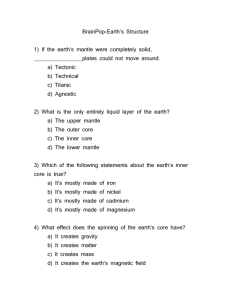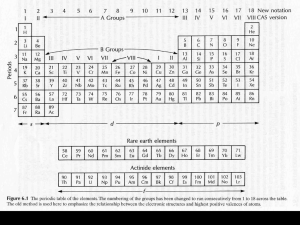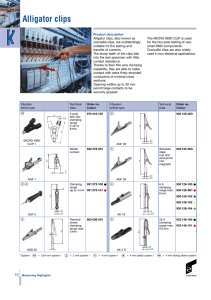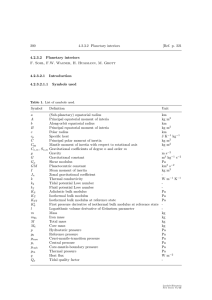Synthesis of hydrocarbons under Deep Earth conditions.
advertisement
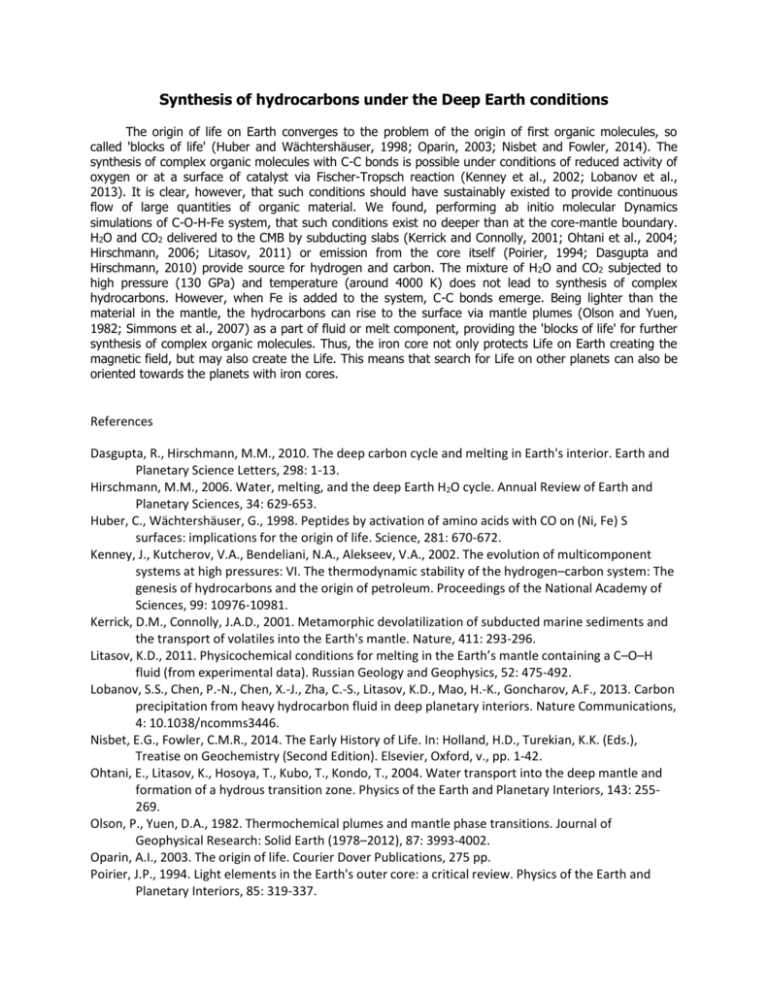
Synthesis of hydrocarbons under the Deep Earth conditions The origin of life on Earth converges to the problem of the origin of first organic molecules, so called 'blocks of life' (Huber and Wächtershäuser, 1998; Oparin, 2003; Nisbet and Fowler, 2014). The synthesis of complex organic molecules with C-C bonds is possible under conditions of reduced activity of oxygen or at a surface of catalyst via Fischer-Tropsch reaction (Kenney et al., 2002; Lobanov et al., 2013). It is clear, however, that such conditions should have sustainably existed to provide continuous flow of large quantities of organic material. We found, performing ab initio molecular Dynamics simulations of C-O-H-Fe system, that such conditions exist no deeper than at the core-mantle boundary. H2O and CO2 delivered to the CMB by subducting slabs (Kerrick and Connolly, 2001; Ohtani et al., 2004; Hirschmann, 2006; Litasov, 2011) or emission from the core itself (Poirier, 1994; Dasgupta and Hirschmann, 2010) provide source for hydrogen and carbon. The mixture of H2O and CO2 subjected to high pressure (130 GPa) and temperature (around 4000 K) does not lead to synthesis of complex hydrocarbons. However, when Fe is added to the system, C-C bonds emerge. Being lighter than the material in the mantle, the hydrocarbons can rise to the surface via mantle plumes (Olson and Yuen, 1982; Simmons et al., 2007) as a part of fluid or melt component, providing the 'blocks of life' for further synthesis of complex organic molecules. Thus, the iron core not only protects Life on Earth creating the magnetic field, but may also create the Life. This means that search for Life on other planets can also be oriented towards the planets with iron cores. References Dasgupta, R., Hirschmann, M.M., 2010. The deep carbon cycle and melting in Earth's interior. Earth and Planetary Science Letters, 298: 1-13. Hirschmann, M.M., 2006. Water, melting, and the deep Earth H2O cycle. Annual Review of Earth and Planetary Sciences, 34: 629-653. Huber, C., Wächtershäuser, G., 1998. Peptides by activation of amino acids with CO on (Ni, Fe) S surfaces: implications for the origin of life. Science, 281: 670-672. Kenney, J., Kutcherov, V.A., Bendeliani, N.A., Alekseev, V.A., 2002. The evolution of multicomponent systems at high pressures: VI. The thermodynamic stability of the hydrogen–carbon system: The genesis of hydrocarbons and the origin of petroleum. Proceedings of the National Academy of Sciences, 99: 10976-10981. Kerrick, D.M., Connolly, J.A.D., 2001. Metamorphic devolatilization of subducted marine sediments and the transport of volatiles into the Earth's mantle. Nature, 411: 293-296. Litasov, K.D., 2011. Physicochemical conditions for melting in the Earth’s mantle containing a C–O–H fluid (from experimental data). Russian Geology and Geophysics, 52: 475-492. Lobanov, S.S., Chen, P.-N., Chen, X.-J., Zha, C.-S., Litasov, K.D., Mao, H.-K., Goncharov, A.F., 2013. Carbon precipitation from heavy hydrocarbon fluid in deep planetary interiors. Nature Communications, 4: 10.1038/ncomms3446. Nisbet, E.G., Fowler, C.M.R., 2014. The Early History of Life. In: Holland, H.D., Turekian, K.K. (Eds.), Treatise on Geochemistry (Second Edition). Elsevier, Oxford, v., pp. 1-42. Ohtani, E., Litasov, K., Hosoya, T., Kubo, T., Kondo, T., 2004. Water transport into the deep mantle and formation of a hydrous transition zone. Physics of the Earth and Planetary Interiors, 143: 255269. Olson, P., Yuen, D.A., 1982. Thermochemical plumes and mantle phase transitions. Journal of Geophysical Research: Solid Earth (1978–2012), 87: 3993-4002. Oparin, A.I., 2003. The origin of life. Courier Dover Publications, 275 pp. Poirier, J.P., 1994. Light elements in the Earth's outer core: a critical review. Physics of the Earth and Planetary Interiors, 85: 319-337. Simmons, N.A., Forte, A.M., Grand, S.P., 2007. Thermochemical structure and dynamics of the African superplume. Geophysical Research Letters, 34.




